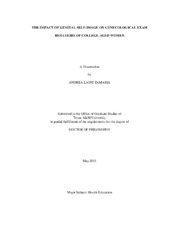| dc.description.abstract | Human papillomavirus (HPV) affects at least half of all sexually active people, especially those aged 20-24 years. Gynecological exams are instrumental in cervical cancer prevention due to the early detection of abnormal cervical cells often caused by HPV. Despite the many benefits of gynecological exams, they continue to be underused. Women are often unaware of exam guidelines, procedures, and costs.
The Theory of Planned Behavior (TPB) was used to predict and explain exam behaviors. A woman’s decision to seek gynecological care may be influenced by numerous factors, including: genital self-image, body image and sexual behaviors. The purpose of this study was to: 1) determine if the TPB explains and predicts exam behaviors, 2) assess if genital self-image, body image and sexual behaviors predict exam behaviors, and 3) evaluate the reliability and validity of data collected on the Female Genital Self-Image Scale (FGSIS) among a sample of female college students.
The study included a convenience sample of 450 women enrolled in health-related courses at a large Southern university in the US. SEM analyses revealed gynecological exam intention was a successful predictor of exam behaviors: Χ2 (81, N = 450) = 258.49, p <> <> <> .001, RMSEA = 0.07, CFI = 0.96 and NFI = 0.95. The addition of genital self-image to the TPB model yielded similar fit indices; however, the TPB alone appears to be more predictive of exam behaviors.
Predictive discriminant analysis (PDA) was used to indicate the predictor, or group of predictors, best suited to predict gynecological exam behavior. PDA results indicate the number of vaginal intercourse partners during the past 3-months was most predictive (hit rate = 68.2%).
A CFA yielded a two-factor FGSIS model: Χ2 (12, N = 450) = 49.77, p <> .001, RMSEA = 0.08, CFI = 0.98 and NFI = 0.97. Reliability assessments indicated very good internal consistency for the entire scale (α = 0.89), for factor one (α = 0.86) and factor two (α = 0.82).
Results have implications for the development of sexual health and women’s health programs targeting factors influencing gynecological exam behaviors. Specifically, scores on the FGSIS can establish relationships between genital self-image and exam behaviors of college women. | en |


